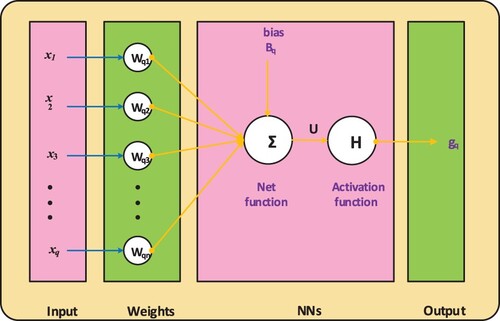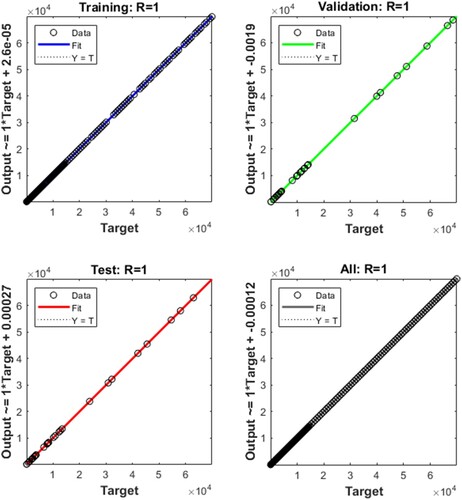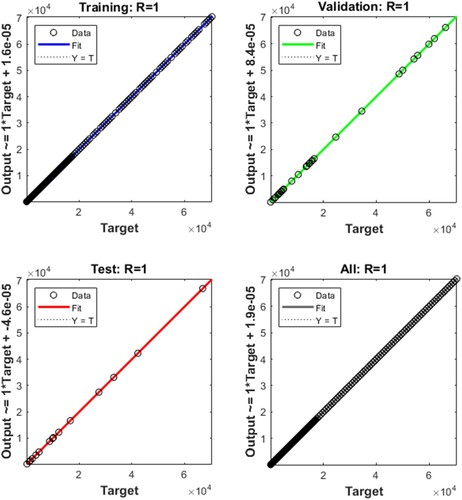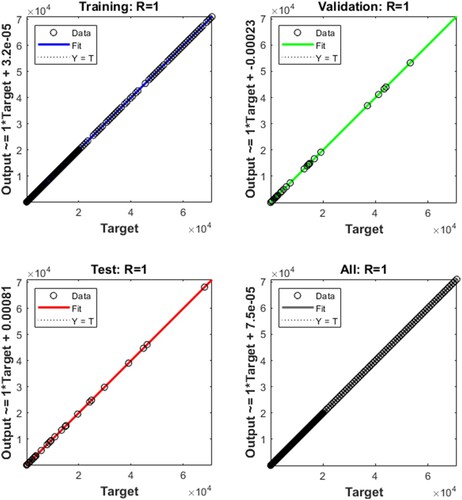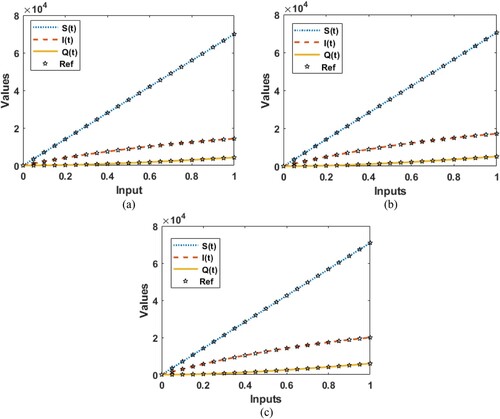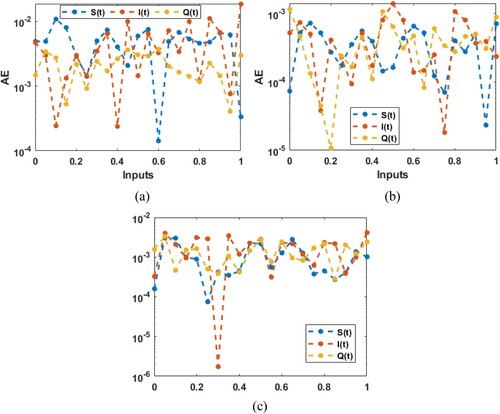 ?Mathematical formulae have been encoded as MathML and are displayed in this HTML version using MathJax in order to improve their display. Uncheck the box to turn MathJax off. This feature requires Javascript. Click on a formula to zoom.
?Mathematical formulae have been encoded as MathML and are displayed in this HTML version using MathJax in order to improve their display. Uncheck the box to turn MathJax off. This feature requires Javascript. Click on a formula to zoom.Abstract
The purpose of this research work is to present a numerical study through artificial neural networks (ANNs) to solve a SIQ-based COVID-19 mathematical model using the effects of lockdown. The effects of lockdown are considered to the three-dimensional mathematical model, “susceptible”, “infective” and “quarantined”, i.e. the SIQ system. ANNs and Levenberg–Marquardt backpropagation (LMB) are used to present the numerical analyses of the SIQ system-based COVID-19. Three different types of authentications, testing and training as sample data are applied to solve the SIQ system. Statistical ratios for the SIQ-based COVID-19 mathematical model are selected – 80% for training and 10% for both testing and authentication. The obtained numerical results of the SIQ mathematical system have been compared with the reference dataset, which is constructed through Adams solutions. The obtained numerical performances of the nonlinear SIQ dynamical model are testified with a reduction of the error in mean square sense in the range of 10−9 to 10−12.
1. Introduction
There are many deathly diseases that can be transmitted from human to human and animals to humans, like HIV, Ebola and dengue [Citation1–Citation4]. One of the serious diseases is COVID-19, which was first revealed in the Chinese city, Wuhan, at the end of 2019. This virus spread across each country of the world and rapidly in humans [Citation5,Citation6]. In a short period of time, COVID-19 spread throughout the whole world with a large number of casualties. The fundamental reason for the propagation of COVID-19 was the transportation or travelling of masses from China to different regions of the world. China started the policy of lockdown and controlled the disease in Wuhan [Citation7,Citation8]. The option available to control COVID is vaccines and targeted drugs. COVID-19 badly hit industries, education sectors, businesses and major economies of the world like the United States of America, India, European countries, Brazil, etc. It is reported in literature that the migration of people plays a substantial role in the spread of infections like flu. It has been noted that immigration not only introduces infections in inherent people, but also alters the occurrence of infections and grows the scenarios of local spread [Citation9]. The migration of individuals from COVID-19 areas has postured a danger to the local populace and increased environmental assortment of the virus rapidly [Citation10].
Until now, a variety of COVID-19–based mathematical models with varied characteristics have been designed and various methodologies have been used on these systems. To mention a few of them, Rhodes et al. [Citation11] presented the ODEs based model for public distress due to COVID-19. Mustafa et al. [Citation12] proposed a mathematical model for analyzing and forecasting the transmission of COVID-19, Benvenuto et al. [Citation13] designed the ARIMA model based on COVID-2019, Sivakumar [Citation14] reviewed the predictive control analysis for COVID-19 in India, Thompson [Citation15] proposed epidemiological models using important tools for guiding COVID-19 interventions, and Nesteruk [Citation16] estimated the COVID-19 pandemic dynamics in Ukraine based on two data sets. Also, Libotte [Citation17] introduced a vaccine administration strategy for COVID-19, Gumel et al. [Citation18] introduced a mathematical model for COVID-19 pandemic, Sadiq et al. [Citation19] discussed the role and impact of nanomaterial in tackling COVID-19 pandemic, and Ortenzi et al. [Citation20] provided transdisciplinary studies of COVID-19 in Italy. Umar [Citation21] implemented theoretical studies for a drug to treat COVID-19, Moore et al. [Citation22] provided a mathematical model for COVID-19 to study the impact of vaccination as well as non-pharmaceutical interventions, Baba et al. [Citation23] introduced rigorous analysis to curtail the spread of COVID-19, and Anirudh [Citation24] narrated the prediction of transmission dynamics of COVID-19. In addition, Zhang et al. [Citation25] described COVID-19 with stochastic perturbation analysis, Chen et al. [Citation26] introduced the impact of social distance in COVID-19 using mathematical modeling and Soumia et al. [Citation27] provided the potential inhibitors of COVID-19.
Alongside many different mathematical models of COVID-19, artificial intelligence (AI) based computing infrastructure is used to exploit the neural networks, and optimization techniques are also widely introduced by the research community for perdition and control of COVID-19 [Citation28–Citation33]. AI-based computing stochastic numerical procedures have been implemented in reported studies of diversified areas [Citation34–Citation37]. A few recent applications of stochastic solvers are the systems of third order governed with Emden–Fowler equations [Citation38,Citation39], heat conduction model [Citation40], periodic differential model [Citation41], a multi-singular system of equations [Citation42,Citation43], delayed, pantograph and prediction differential system [Citation44], functional differential models [Citation45] and differential fractional order models [Citation46], food chain models [Citation47,Citation48], atomic physics [Citation49], dusty plasma [Citation50], electric circuits [Citation51], thermal explosion model [Citation52], financial models [Citation53] and environment economic models [Citation54]. Additionally, these stochastic solvers are extensively exploited for providing an accurate, robust, reliable and consistent platform for numerical treatment of the solution dynamics of COVID-19 mathematical models [Citation55–Citation58]. These are potential motivational facts for authors to exploit the knack of AI-based numerical solvers for the analysis of COVID-19 mathematical models. The computing stochastic numerical procedures have been implemented in diverse domains of applied sciences; however, the nonlinear SIQ dynamical system based COVID-19 propagation studies involving lockdown impacts [Citation59] look promising to solve with AI-based numerical procedures.
The aim of this work is to provide the solution dynamics of the nonlinear SIQ dynamical system based COVID-19 using the knack of AI via artificial neural networks (ANNs) and Levenberg–Marquardt backpropagation (LMB). The dynamical models have various applications in different sectors [Citation60–Citation63]. The contribution and innovative insights of the computing stochastic numerical procedures are provided as follows:
Design of novel computing stochastic numerical procedure inspired by knacks of AI via ANNs-LMB is introduced viably for the numerical treatment of the nonlinear SIQ dynamical system of COVID-19.
Competency of Adams numerical solver is exploited for creating data samples used for testing, validating and training ANNs-LMB to construct networks for approximate solution dynamics of the COVID-19 mathematical model.
The precise and consistent overlapping of the numerical outcomes in good agreement with standard solutions with slight absolute error (AE) verifies the value of the computing stochastic procedure for the SIQ dynamical system of COVID-19.
Analysis through error histograms (EHs), MSE-based convergence curves, correlation and regression substantiate the computing stochastic procedure.
The rest of the paper is organized as follows: The numerical measures to solve the nonlinear SIQ model using the ANNs-LMB are labeled in Section 2. The numerical performances through ANNs-LMB are described in Section 3. The conclusions along with future guidance are provided in Section 4.
2. System model: SIQ-based nonlinear COVID-19
This study emphasizes the lockdown effects as precautionary measures based on mathematical models. The COVID-19 based SIQ system has three classes: susceptible S(t), infective I(t) and quarantined Q(t). The general form of the SIQ mathematical system is presented as [Citation59]
(1)
(1)
The comprehensive details of nonlinear SIQ models are shown in Table . A further description of the selection of appropriate values or intervals of these parameters can be seen in reference [Citation59] with their local and global stabilities as well as optimal control sensitivity. Whereas in the present research work, we confined our studies to the numerical treatment of systems of ODEs in set (1) by exploiting knacks of AI via design ANNs-LMB.
Table 1. Comprehensive details of each parameter of the nonlinear SIQ system.
3. Methodology: artificial neural networks-Levenberg–Marquardt backpropagation
The proposed computing stochastic numerical procedure is delivered in two steps for the SIQ dynamical COVID-19 system.
Critical and detailed explanations are provided for the computing stochastic numerical procedure based ANNs-LMB.
Implementation procedures support the computing stochastic numerical procedure for the SIQ dynamical COVID-19 system.
An appropriate design process flow structure using the computing stochastic numerical procedure of the SIQ dynamical COVID-19 model is plotted in Figure . ANNs-LMB operates through the multi-layers developed in Figure . The procedure is applied in “MATLAB” using layer structure, i.e. single input, output and hidden layers, 10 hidden neurons, n-fold cross validation, log-sigmoid activation function, 1000 epochs, and Levenberg–Marquardt optimization algorithm with default values of iteration, stoppage limits, tolerances and step size that are used for training. Also, label data for input and targets are obtained from standard numerical solution, while 80% of arbitrary data are selected for training and 10% for both testing and validation, respectively.
Figure 1. Workflow structure of the proposed stochastic structure for the SIQ dynamical model of COVID-19.
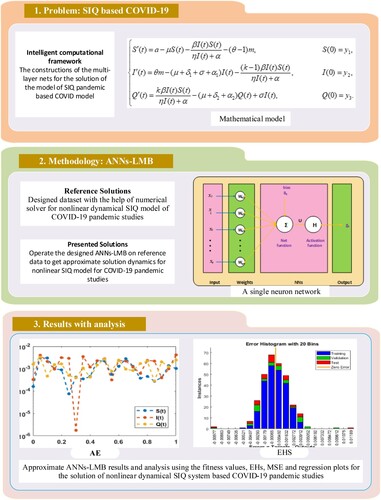
Inspired by the related recent studies [Citation64–Citation70], the proposed neural network models with 10 neurons are taken on the basis of the best compromise between overfitting and underfitting of neural networks in the process of training and validation with epochs 1000. If we take a smaller number of neurons, we may encounter the issues of underfitting, i.e. results in premature convergence, while taking more neurons, i.e. greater than 10, may encounter the overfitting problem, i.e. similar accuracy with higher complexity. The training, testing and validation samples for the ANNs-LMB procedure are chosen arbitrarily with 80%, 10% and 10%, respectively. If we have a smaller number of samples for training i.e. 40%–60%, then the MSE for testing increases from 20% to 30% and results in overall poor performance of the algorithm. On the other hand, if we have more samples for training like 90%, and 5% testing and validation, the accuracy of the algorithm slightly increases for the label data, i.e. bias input and targets, but robustness of the scheme is not rigorously verified for unbiased data without prior knowledge of the targets.
4. Results of numerical simulations with interpretation
Three variants of the nonlinear SIQ dynamical system of COVID-19 through the ANNs-LMB have been presented in this section. The mathematical representations of each variant are provided as
Case 1: Consider the nonlinear SIQ dynamical system of COVID-19 with given as
(2)
(2)
Case 2: Consider the nonlinear SIQ dynamical system of COVID-19 with
written as
(3)
(3)
Case 3: Consider the nonlinear SIQ dynamical system of COVID-19 with
shown as
(4)
(4)
The numerical representations are provided for the nonlinear SIQ dynamical model of COVID-19 in input span [0, 1]. The command “nftool” in Matlab is applied to solve the SIQ dynamical system of COVID-19 using 10 neurons with the selected 80% for training and 10% for both authentication and testing. The obtained performances for the SIQ dynamical system of COVID-19 are plotted in Figure .
The graphs through the calculated results for the SIQ dynamical model based COVID-19 are plotted in Figures . The proficient procedures of all three variants of the SIQ dynamical nonlinear system based COVID-19 are derived in Figure using the states of performances and transitions. The calculated MSE measures for best curves, training, authentication and testing are provided in Figure (a–c), while the state transitions are plotted in Figure (d–f) to solve the SIQ dynamical nonlinear system based COVID-19. The best results of the performances for the SIQ dynamical model are drawn at epoch 1000, which lie around 4.002 × 10−05, 3.454 × 10−07 and 1.449 × 10−05, respectively. The gradient values for the SIQ dynamical system based COVID-19 are found as 2.89, 1.87 and 2.95, respectively. These graphical presentations designate the convergence and exactness of the SIQ dynamical system based COVID-19. The fitting curves are plotted in Figure (a–c) for each SIQ dynamical system based COVID-19, which shows the comparison of obtained and reference results. Figure (d–f) is drawn on the basis of EHs to solve the SIQ dynamical system based COVID-19 using the ANNs-LMB. It is observed that the EHs values for case 1 lie around 1.457 × 10−03, −2.1 × 10−05 and 4.92 × 10−04, respectively.
Figure 4. MSE and state transitions for the SIQ dynamical COVID-19 model. (a) Case 1: MSE, (b) Case 2: MSE, (c) Case 3: MSE, (d) Case 1: Values of the state transition, (e) Case 2: Values of the state transition, (f) Values of the state transition.
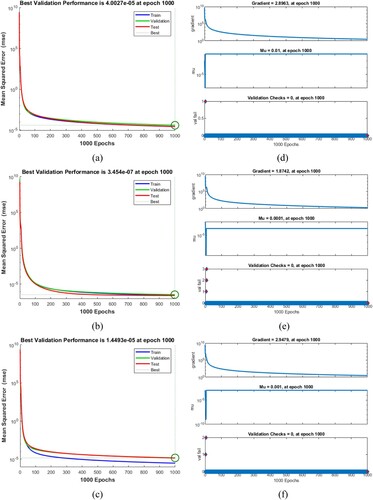
Figure 5. Comparison and EHs values using the ANNs-LMB to solve the SIQ dynamical system based COVID-19. (a) Case 1: Comparison, (b) Case 2: Comparison, (c) Case 3: Comparison, (d) Case 1: EHs, (e) Case 2: EHs, (f) Case 3: EHs.
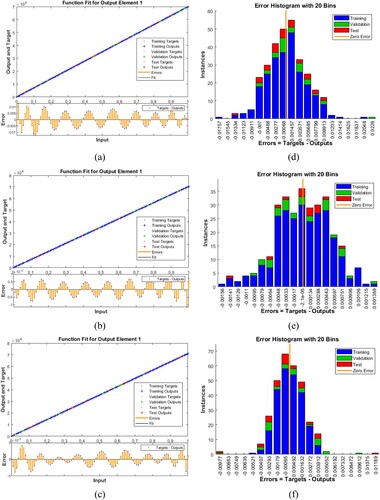
The correlation measures are plotted in Figures that indicate the regression performances. The correlation performances in terms of the coefficient of determination, i.e. values of R2, lie around 1 to solve the SIQ dynamical system based COVID-19. These best plots of testing, training and verification indicate the precision of the scheme. The MSE-based convergence based on the training, epochs, authentication, testing, backpropagation measures and complexity are provided in Table to solve the SIQ dynamical system based COVID-19. The computational complexity of the algorithm is determined by calculating the time spent for the training of networks, i.e. execution of all 1000 epochs, for the solution dynamics of SIQ dynamical system based COVID-19. The outcomes of the complexity presented in Table show that the ANNs-LMB algorithm takes around 5 ± 1 s for all three cases of SIQ dynamical system based COVID-19.
Table 2. Proposed ANNs-LMB for the SIQ dynamical COVID-19 model.
Figures and indicate the comparison plots and AE of the obtained and reference results to solve the nonlinear dynamical SIQ model. It is indicated that the reference and obtained results exactly overlapped for each variant of the nonlinear dynamical SIQ model. This perfect overlapping of the results indicates the exactness and perfection of the designed ANNs-LMB. The AE values for each case of the nonlinear dynamical SIQ model are provided in Figure . It is observed that the AE is found in good measures for each case of the nonlinear dynamical SIQ model using the ANNs-LMB. One can observe that the designed scheme is accurate and precise to solve the nonlinear SIQ model.
5. Concluding remarks
The aim of the present study is to present the numerical solutions of the nonlinear dynamical SIQ mathematical model based on COVID-19 using the ANNs-LMB. The SIQ model is dependent on three dimensions, “susceptible”, “infective” and “quarantined”, i.e. the SIQ system. The authentication, testing and training as sample data are applied in ANNs-LMB for the SIQ system. The data based on the statistics to solve the SIQ mathematical model are selected as 80% for training and 10% for both testing and validation. The obtained numerical results of the SIQ mathematical system have been compared with the reference dataset, which is constructed through the Adams solutions. One can see that the obtained results overlapped with the reference solution, which indicates the exactness of the scheme. The obtained results based on the nonlinear SIQ dynamical model are testified to reduce the MSE. To observe the exactness, trustworthiness, and efficiency of the scheme, the procedures are accomplished using the MSE, correlation, EHs and regression. Moreover, the plots of AE designate a better performance of the scheme for the SIQ model.
In future, the designed procedures through the ANNs-LMB can be implemented to present the numerical solutions of the computational fluidic systems, fractional order models, computer virus models and bioinformatics studies.
Data availability statement
All data generated or analyzed during this study are included in this article.
Additional information
Funding
References
- Umar M, et al. Stochastic numerical technique for solving HIV infection model of CD4+ T cells. Eur Phys J Plus. 2020;135(5):403.
- Guerrero–Sánchez Y, et al. Solving a class of biological HIV infection model of latently infected cells using heuristic approach. Discrete Contin Dyn Syst-S. 2020;14(10):3611.
- Umar M, et al. A novel study of Morlet neural networks to solve the nonlinear HIV infection system of latently infected cells. Results Phys. 2021;25:104235.
- Umar M, et al. A stochastic numerical computing heuristic of SIR nonlinear model based on dengue fever. Results Phys. 2020;19:103585.
- Lahiri A, Jha SS, Bhattacharya S. Effectiveness of preventive measures against COVID-19: A systematic review of In Silico modeling studies in indian context. Indian Journal of Public Health. 2020;64(6):156.
- Hao X, Cheng S, Wu D, et al. Reconstruction of the full transmission dynamics of COVID-19 in Wuhan. Nature. 2020;584(7821):420–424.
- Sánchez YG, et al. Design of a nonlinear SITR fractal model based on the dynamics of a novel coronavirus (COVID-19). Fractals. 2020;28(08):2040026.
- Elsonbaty A, et al. Dynamical analysis of a novel discrete fractional SITRS model for COVID-19. Fractals. 2021;29(8):2140035.
- Spiteri G, et al. First cases of coronavirus disease 2019 (COVID-19) in the WHO European Region, 24 January to 21 February 2020. Eurosurveillance. 2020;25(9):2000178.
- Shim E. A note on epidemic models with infective immigrants and vaccination. Math Biosci Eng. 2006;3(3):557–566.
- Rhodes T, et al. Mathematical models as public troubles in COVID-19 infection control: following the numbers. Health Sociol Rev. 2020;29(2):177–194.
- Mustafa SK, et al. (2020). Brief review of the mathematical models for analyzing and forecasting transmission of COVID-19.
- Benvenuto D, et al. Application of the ARIMA model on the COVID-2019 epidemic dataset. Data Brief. 2020;29:105340.
- Bherwani H, Gupta A, Anjum S, et al. Exploring dependence of COVID-19 on environmental factors and spread prediction in India. npj Climate and Atmospheric Science. 2020;3(1):1-13.
- Thompson RN. Epidemiological models are important tools for guiding COVID-19 interventions. BMC Med. 2020;18:1–4.
- Nesteruk I. Estimates of the COVID-19 pandemic dynamics in Ukraine based on two data sets. medRxiv. 2021.
- Libotte GB, Lobato FS, Platt GM, et al. Determination of an optimal control strategy for vaccine administration in COVID-19 pandemic treatment. Comput Methods Programs Biomed. 2020;196:105664.
- Gumel AB, et al. A primer on using mathematics to understand COVID-19 dynamics: modeling, analysis and simulations. Infect Dis Model. 2021;6:148–168.
- Sadiq IZ, Abubakar FS, Dan-Iya BI. Role of nanoparticles in tackling COVID-19 pandemic: a bio-nanomedical approach. J Taibah Univ Sci. 2021;15(1):198–207.
- Ortenzi F, et al. A transdisciplinary analysis of COVID-19 in Italy: the most affected country in Europe. Int J Environ Res Public Health. 2020;17(24):9488.
- Umar Y. Theoretical studies of the rotational and tautomeric states, electronic and spectroscopic properties of favipiravir and its structural analogues: a potential drug for the treatment of COVID-19. J Taibah Univ Sci. 2020;14(1):1613–1625.
- Moore S, et al. Vaccination and non-pharmaceutical interventions for COVID-19: a mathematical modelling study. Lancet Infect Dis. 2021;21(6):793–802.
- Baba IA, Baba BA, Esmaili P. A mathematical model to study the effectiveness of some of the strategies adopted in curtailing the spread of COVID-19. Comput Math Methods Med. 2020;2020:6. doi:10.1155/2020/5248569
- Anirudh AJIDM. Mathematical modeling and the transmission dynamics in predicting the COVID-19-what next in combating the pandemic. Infect Dis Model. 2020;5:366–374.
- Zhang Z, et al. Dynamics of COVID-19 mathematical model with stochastic perturbation. Adv Differ Equ. 2020;2020(1):1–12.
- Chen X, et al. Compliance and containment in social distancing: mathematical modeling of COVID-19 across townships. Int J Geogr Inf Sci. 2021;35(3):446–465.
- Soumia M, Hanane Z, Benaissa M, et al. Towards potential inhibitors of COVID-19 main protease Mpro by virtual screening and molecular docking study. J. Taibah Univ. Sci.. 2020;14(1):1626–1636.
- Ozturk T, Talo M, Yildirim EA, et al. Automated detection of COVID-19 cases using deep neural networks with X-ray images. Comput Biol Med. 2020;121:103792.
- Niazkar HR, Niazkar M. Application of artificial neural networks to predict the COVID-19 outbreak. Glob Health Res Policy. 2020;5(1):1–11.
- Saba AI, Elsheikh AH. Forecasting the prevalence of COVID-19 outbreak in Egypt using nonlinear autoregressive artificial neural networks. Process Saf Environ Prot. 2020;141:1–8.
- Ozturka T, Talob M, Yildirimc EA, et al. Automated detection of COVID-19 cases using deep neural networks with X-ray images. Comput Biol Med. 2020;121(103792):10–1016.
- Pham TD. A comprehensive study on classification of COVID-19 on computed tomography with pretrained convolutional neural networks. Sci Rep. 2020;10(1):1–8.
- Hamadneh NN, Khan WA, Ashraf W, et al. Artificial neural networks for prediction of COVID-19 in Saudi Arabia. Comput Mater Contin. 2021;66: 2787–2796.
- Nisar K, et al. Evolutionary integrated heuristic with Gudermannian neural networks for second kind of Lane–Emden nonlinear singular models. Appl Sci. 2021;11(11):4725, doi:10.3390/app11114725.
- Sabir Z, et al. Heuristic computing technique for numerical solutions of nonlinear fourth order Emden–Fowler equation. Math Comput Simul. 2020;178:534–548.
- Nisar K, Sabir Z, Raja MAZ, et al. Design of Morlet wavelet neural network for solving a class of singular pantograph nonlinear differential models. IEEE Access. 2021;9:77845–77862.
- Sabir Z, et al. Neuro-evolution computing for nonlinear multi-singular system of third order Emden–Fowler equation. Math Comput Simul. 2021;185:799–812.
- Sabir Z, et al. Integrated intelligent computing paradigm for nonlinear multi-singular third-order Emden–Fowler equation. Neural Comput Appl. 2021;33(8):3417–3436.
- Sabir Z, et al. Design of neuro-swarming-based heuristics to solve the third-order nonlinear multi-singular Emden–Fowler equation. Eur Phys J Plus. 2020;135(5):410.
- Raja MAZ, et al. A new stochastic computing paradigm for the dynamics of nonlinear singular heat conduction model of the human head. Eur Phys J Plus. 2018;133(9):364.
- Sabir Z, et al. Evolutionary computing for nonlinear singular boundary value problems using neural network, genetic algorithm and active-set algorithm. Eur Phys J Plus. 2021;136(2):1–19.
- Raja MAZ, et al. Numerical solution of doubly singular nonlinear systems using neural networks-based integrated intelligent computing. Neural Comput Appl. 2019;31(3):793–812.
- Sabir Z, et al. FMNEICS: fractional Meyer neuro-evolution-based intelligent computing solver for doubly singular multi-fractional order Lane–Emden system. Comput Appl Math. 2020;39(4):1–18.
- Sabir Z, Wahab HA, Guirao JL. Integrated neuro-evolution heuristic with sequential quadratic programming for second-order prediction differential models. Numer Methods Partial Differ Equ. 2022;19(1):663–687.
- Sabir Z, et al. Neuro-swarm intelligent computing to solve the second-order singular functional differential model. Eur Phys J Plus. 2020;135(6):1–19.
- Sabir Z, et al. A novel design of fractional Meyer wavelet neural networks with application to the nonlinear singular fractional Lane-Emden systems. Alexandria Eng J. 2021;60(2):2641–2659.
- Sabir Z. Stochastic numerical investigations for nonlinear three-species food chain system. Int J Biomath. 2022;15(04):2250005.
- Sabir Z, Ali MR, Sadat R. Gudermannian neural networks using the optimization procedures of genetic algorithm and active set approach for the three-species food chain nonlinear model. J Ambient Intell Humaniz Comput. 2022: 1–10. doi:10.1007/s12652-021-03638-3
- Ahmad SI, et al. A new heuristic computational solver for nonlinear singular Thomas–Fermi system using evolutionary optimized cubic splines. Eur Phys J Plus. 2020;135(1):1–29.
- Bukhari AH, et al. Design of a hybrid NAR-RBFs neural network for nonlinear dusty plasma system. Alexandria Eng J. 2020;59(5):3325–3345.
- Mehmood A, et al. Integrated computational intelligent paradigm for nonlinear electric circuit models using neural networks, genetic algorithms and sequential quadratic programming. Neural Comput Appl. 2020;32(14):10337–10357.
- Sabir Z. Neuron analysis through the swarming procedures for the singular two-point boundary value problems arising in the theory of thermal explosion. Eur Phys J Plus. 2022;137(5):638.
- Bukhari AH, et al. Fractional neuro-sequential ARFIMA-LSTM for financial market forecasting. IEEE Access. 2020;8:71326–71338.
- Kiani AK, et al. Intelligent backpropagation networks with Bayesian regularization for mathematical models of environmental economic systems. Sustainability. 2021;13(17):9537.
- Umar M, et al. Integrated neuro-swarm heuristic with interior-point for nonlinear SITR model for dynamics of novel COVID-19. Alexandria Eng J. 2021;60(3):2811–2824.
- Umar M, et al. A stochastic intelligent computing with neuro-evolution heuristics for nonlinear SITR system of novel COVID-19 dynamics. Symmetry (Basel). 2020;12(10):1628.
- Cheema TN, et al. Intelligent computing with Levenberg–Marquardt artificial neural networks for nonlinear system of COVID-19 epidemic model for future generation disease control. Eur Phys J Plus. 2020;135(11):1–35.
- Botmart T, Sabir Z, Javeed S, et al. Artificial neural network-based heuristic to solve COVID-19 model including government strategies and individual responses. Inform Med Unlocked. 2022;33:101028. doi:10.1016/j.imu.2022.101028.
- Bhadauria AS, et al. A SIQ mathematical model on COVID-19 investigating the lockdown effect. Infect Dis Model. 2021;6:244–257.
- Iqbal M, Seadawy AR, Khalil OH, et al. Propagation of long internal waves in density stratified ocean for the (2 + 1)-dimensional nonlinear Nizhnik-Novikov-Vesselov dynamical equation. Results Phys. 2020;16:102838.
- Baskonus HM, Bulut H. New wave behaviors of the system of equations for the ion sound and Langmuir waves. Waves in Random and Complex Media. 2016;26(4):613–625.
- Iqbal M, Seadawy AR. Instability of modulation wave train and disturbance of time period in slightly stable media for unstable nonlinear Schrödinger dynamical equation. Mod Phys Lett B. 2020;34(supp01):2150010.
- Seadawy AR, Iqbal M. Propagation of the nonlinear damped Korteweg-de Vries equation in an unmagnetized collisional dusty plasma via analytical mathematical methods. Math Methods Appl Sci. 2021;44(1):737–748.
- Awais M, et al. Intelligent numerical computing paradigm for heat transfer effects in a Bodewadt flow. Surf Interfaces. 2021;26:101321.
- Awan SE, et al. Intelligent Bayesian regularization networks for bio-convective nanofluid flow model involving gyro-tactic organisms with viscous dissipation, stratification and heat immersion. Eng Appl Comput Fluid Mech. 2021;15(1):1508–1530.
- Shoaib M, et al. Soft computing paradigm for Ferrofluid by exponentially stretched surface in the presence of magnetic dipole and heat transfer. Alexandria Eng J. 2022;61(2):1607–1623.
- Naz S, et al. Neuro-intelligent networks for Bouc–Wen hysteresis model for piezostage actuator. Eur Phys J Plus. 2021;136(4):1–20.
- Elzeki OM, Shams M, Sarhan S, et al. COVID-19: a new deep learning computer-aided model for classification. PeerJ Comput Sci. 2021;7:e358.
- Elzeki OM, Abd Elfattah M, Salem H, et al. A novel perceptual two layer image fusion using deep learning for imbalanced COVID-19 dataset. PeerJ Computer Science. 2021;7:e364.
- Shams MY, Elzeki OM, Abouelmagd LM, et al. HANA: a healthy artificial nutrition analysis model during COVID-19 pandemic. Comput Biol Med. 2021;135:104606.

